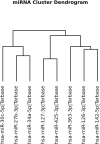Dairy cow performance is associated with longitudinal microRNA profiles
- PMID: 40748909
- PMCID: PMC12316255
- DOI: 10.1371/journal.pone.0328765
Dairy cow performance is associated with longitudinal microRNA profiles
Abstract
Modern high producing dairy cows are still affected by poor fertility and disease, despite improvements achieved through genetic selection programs. Additional biomarkers of health and performance traits in cattle could enhance animal welfare and profitability by allowing farmers to cull animals before problems occur. We performed pilot investigations of plasma microRNA (miRNA) profiles during early life as potential biomarkers associated with future performance in dairy cows. The latter included survival to two years of age, age at first calving, yield of milk, fat and protein, mastitis and lameness traits, conception rate, number of services per conception, and calving interval. Using qPCR, we obtained longitudinal measurements and ratios involving nine miRNAs (miR-126-3p, miR-127, miR-142-5p, miR-154b, miR-27b, miR-30c-5p, miR-34a, miR-363, miR-425-3p) in plasma samples from three age groups: calves (<1 month), heifers (14-23 months), and first lactation cows (29-35 months). Changes in miR-126-3p from calf to first lactation cow were associated with first lactation milk yield and second lactation milk somatic cell count (an udder health indicator). Moreover, the miR-127 to miR-30c-5p ratio in cows was associated with milk fat and protein yield in the first two lactations, whereas miR-142-5p levels and several miRNA ratios involving this miRNA, were associated with second calving interval (a cow fertility trait). Our results identified novel early life biomarkers that warrant further investigation to determine whether they may predict dairy cattle performance.
Copyright: © 2025 MacLeay et al. This is an open access article distributed under the terms of the Creative Commons Attribution License, which permits unrestricted use, distribution, and reproduction in any medium, provided the original author and source are credited.
Conflict of interest statement
The authors have declared that no competing interests exist.
Figures




Similar articles
-
Use of early-lactation milk Fourier-transform mid-infrared spectroscopy and farm data to predict the calving-to-conception interval in Chinese dairy cows.J Dairy Sci. 2025 Sep;108(9):9741-9754. doi: 10.3168/jds.2025-26495. Epub 2025 Jul 16. J Dairy Sci. 2025. PMID: 40675473
-
Investigating the relationship between dairy dam preconception and gestation characteristics and heifer offspring variables from birth to lactation.J Dairy Sci. 2025 Jul;108(7):7758-7774. doi: 10.3168/jds.2024-26138. Epub 2025 Apr 28. J Dairy Sci. 2025. PMID: 40306426
-
Dynamics and impacts of staphylococcal intramammary infections during dairy cows' nonlactating periods.J Dairy Sci. 2025 Jul 9:S0022-0302(25)00516-8. doi: 10.3168/jds.2025-26662. Online ahead of print. J Dairy Sci. 2025. PMID: 40645493
-
Invited review: effect of udder health management practices on herd somatic cell count.J Dairy Sci. 2011 Feb;94(2):563-79. doi: 10.3168/jds.2010-3715. J Dairy Sci. 2011. PMID: 21257026
-
Reducing dietary protein in dairy cow diets: implications for nitrogen utilization, milk production, welfare and fertility.Animal. 2014 Feb;8(2):262-74. doi: 10.1017/S1751731113002139. Epub 2013 Dec 2. Animal. 2014. PMID: 24290203
References
-
- Buckley F, O’Sullivan K, Mee JF, Evans RD, Dillon P. Relationships among milk yield, body condition, cow weight, and reproduction in spring-calved Holstein-Friesians. J Dairy Sci. 2003;86(7):2308–19. - PubMed
-
- Miglior F, Chesnais J, Van Doormaal BJ, Food G, Canada A, Network CD, et al. Genetic improvement: a major component of increased dairy farm profitability. In: 38th International Committee for Animal Recording. 2012. p. 1–13.
-
- Cooke JS, Cheng Z, Bourne NE, Wathes DC. Association between growth rates, age at first calving and subsequent fertility, milk production and survival in Holstein-Friesian heifers. Open J Anim Sci. 2013;3(1):1–12.
MeSH terms
Substances
LinkOut - more resources
Full Text Sources

